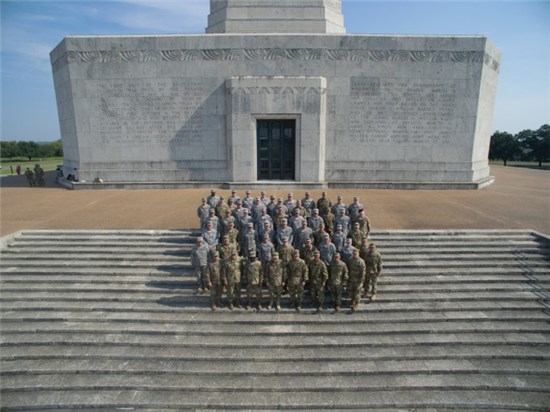 Commentary by LT Zachary West 100th MPAD
Commentary by LT Zachary West 100th MPAD
LA PORTE, Texas – On a hot, humid morning in late September, the commanding officers of the Texas Army National Guard gathered in the prolific shadow of the 567-foot San Jacinto Monument. One of the tour guides fished a Kentucky rifle out of his truck and began reviewing the specifications of the venerable nineteenth-century weapon. The temperature seemed to rise several degrees every minute, and with the heat came swarms of hungry mosquitos.
Thus began the annual Texas Army National Guard Commanding General’s Staff Ride. Since the first staff ride in 1906, at the Chattanooga battlefield in Tennessee, these events have served as a powerful and enduring tool to further the professional development of U.S. Army officers. Texas, with its particularly colorful and often violent history, offers plenty of sites to accommodate Army staff rides.
This year’s location holds a special place in the heart of every Texan: San Jacinto, where Gen. Sam Houston and the last of his embattled Texan rebels mounted a daring and strategically devastating assault against an overextended Mexican invasion force. After just 18 minutes of combat, 11 Texans and some 650 Mexicans had fallen.
Despite this astonishing victory, the true triumph came shortly after: Gen. Santa Anna, the totalitarian leader of Mexico, fell into Texan hands twenty-four hours later. Chased out of his camp by the Texans’ attack at San Jacinto, Santa Anna donned the clothes of a junior enlisted soldier and went on the run. He was soon picked up by a Texan patrol, but his identity remained a secret until he arrived at a hasty camp for Mexican prisoners.
“He had spent so long inculcating extreme drill and protocol into the ranks of his army,” the tour guide told the commanders, “that his men didn’t think twice about saluting him and calling out his name in front of their captors.” The Texans brought Santa Anna to Sam Houston, who gave the Mexican leader an ultimatum: Sign a treaty granting full independence to Texas, or hang by the neck from the nearest live oak. After three weeks of negotiation, the disgraced Santa Anna signed an agreement, and the Republic of Texas was born.
One hundred seventy-nine years later, no one would call the Texas Army National Guard an underdog. From the mounted charges of the Mexican-American War to the brutal Comanche ambushes atop the Llano Estacado, from the perilous landing in the Gulf of Salerno to the nighttime raids in Korengal Valley, Texas military and irregular forces have earned a reputation as fearsome, cunning warfighters. Yet, every victory traces back to that warm April morning in 1836, when an exhausted, badly-outnumbered group of rebels managed to defeat one of the greatest armies in North America.
The officers at the staff ride who stood and listened to the history of this battle are the collective embodiment of its legacy. They may have arrived in helicopters and taken digital photos with smart phones, but the reason they wear the uniform hasn’t changed in almost two centuries. Staff rides like this remind them that they might one day be in Sam Houston’s shoes, with the odds never worse and the stakes never higher. If, or perhaps when, that day comes, they must echo the raw determination and deadly cunning of our Texan ancestors, who, beneath the San Jacinto sky, won the right to call themselves free in a storm of fire and blood.